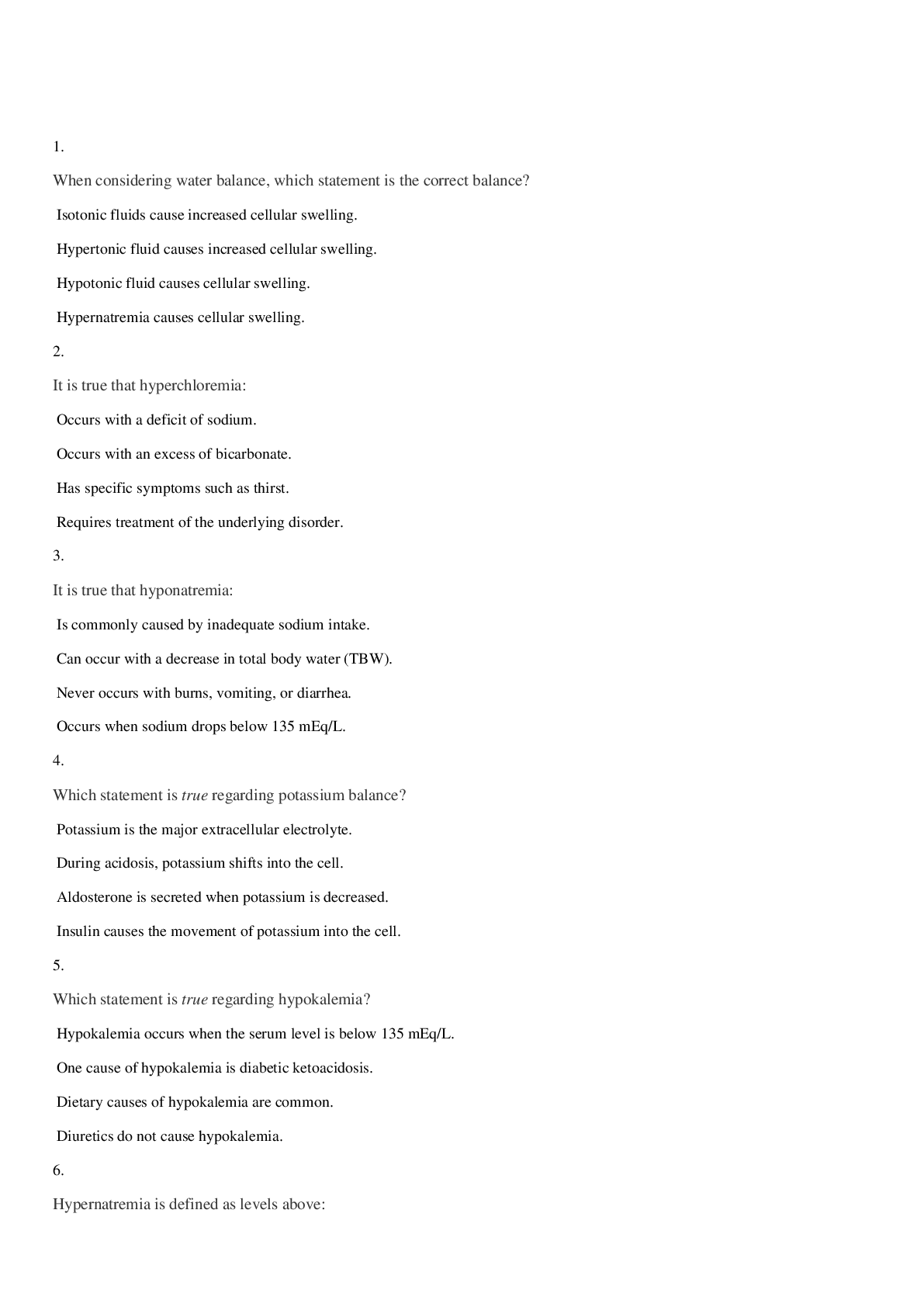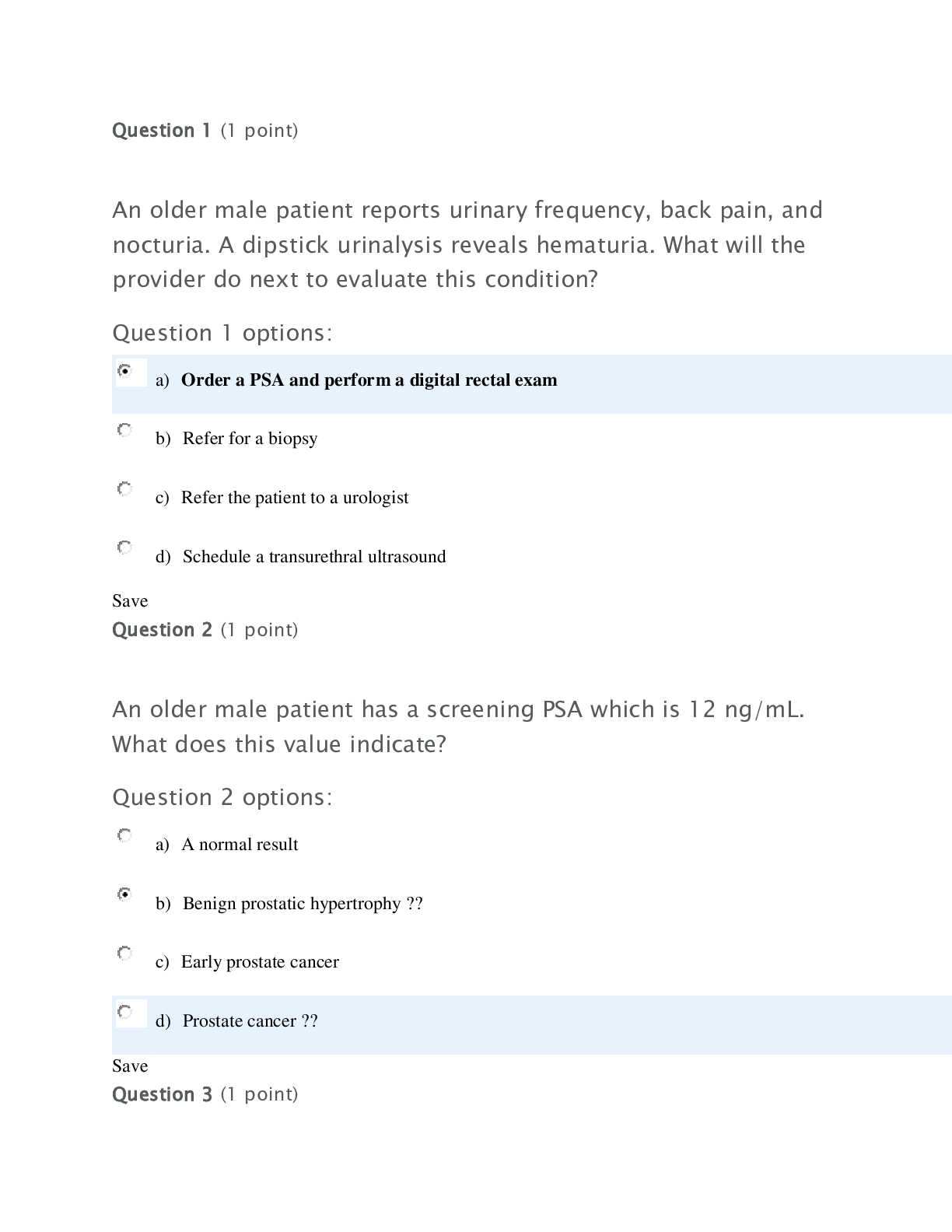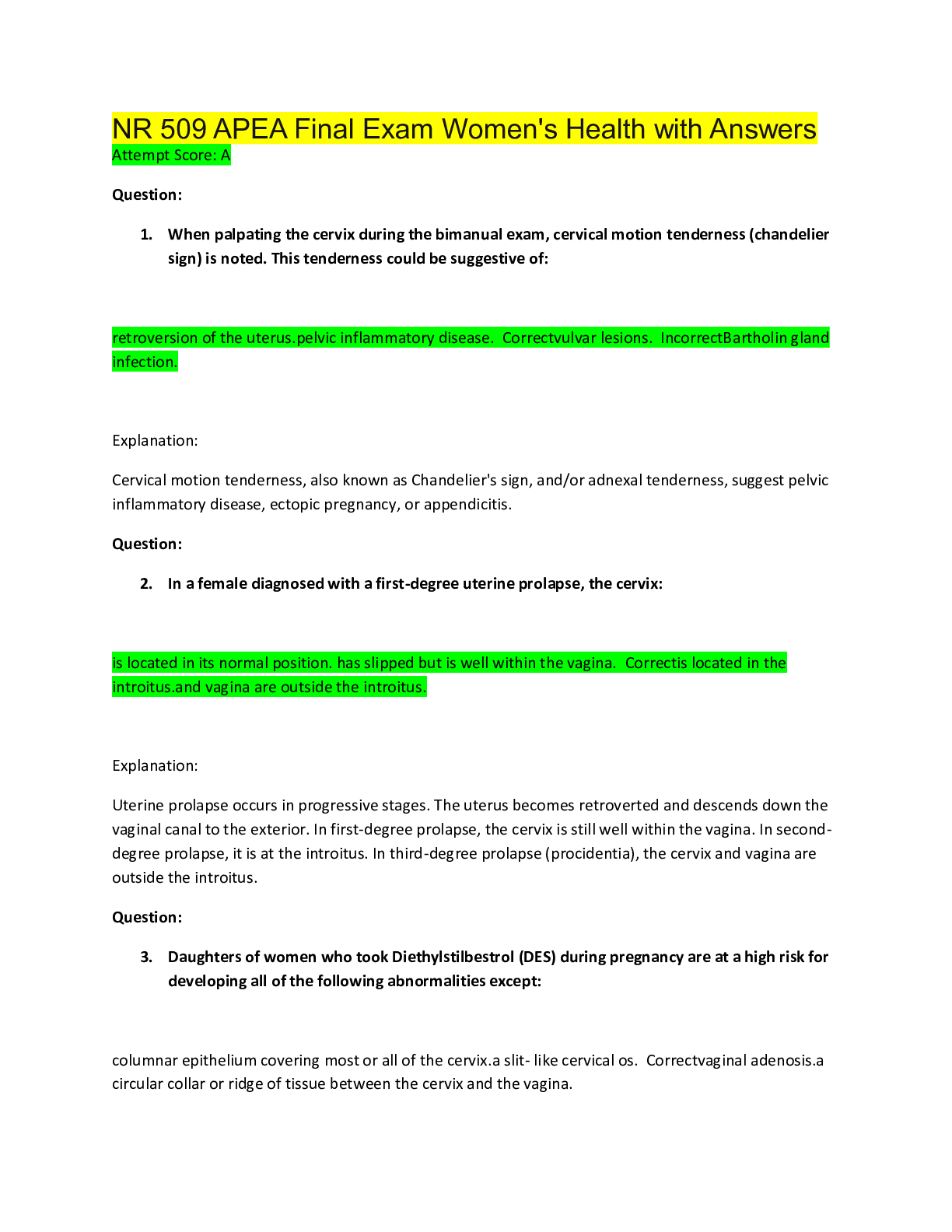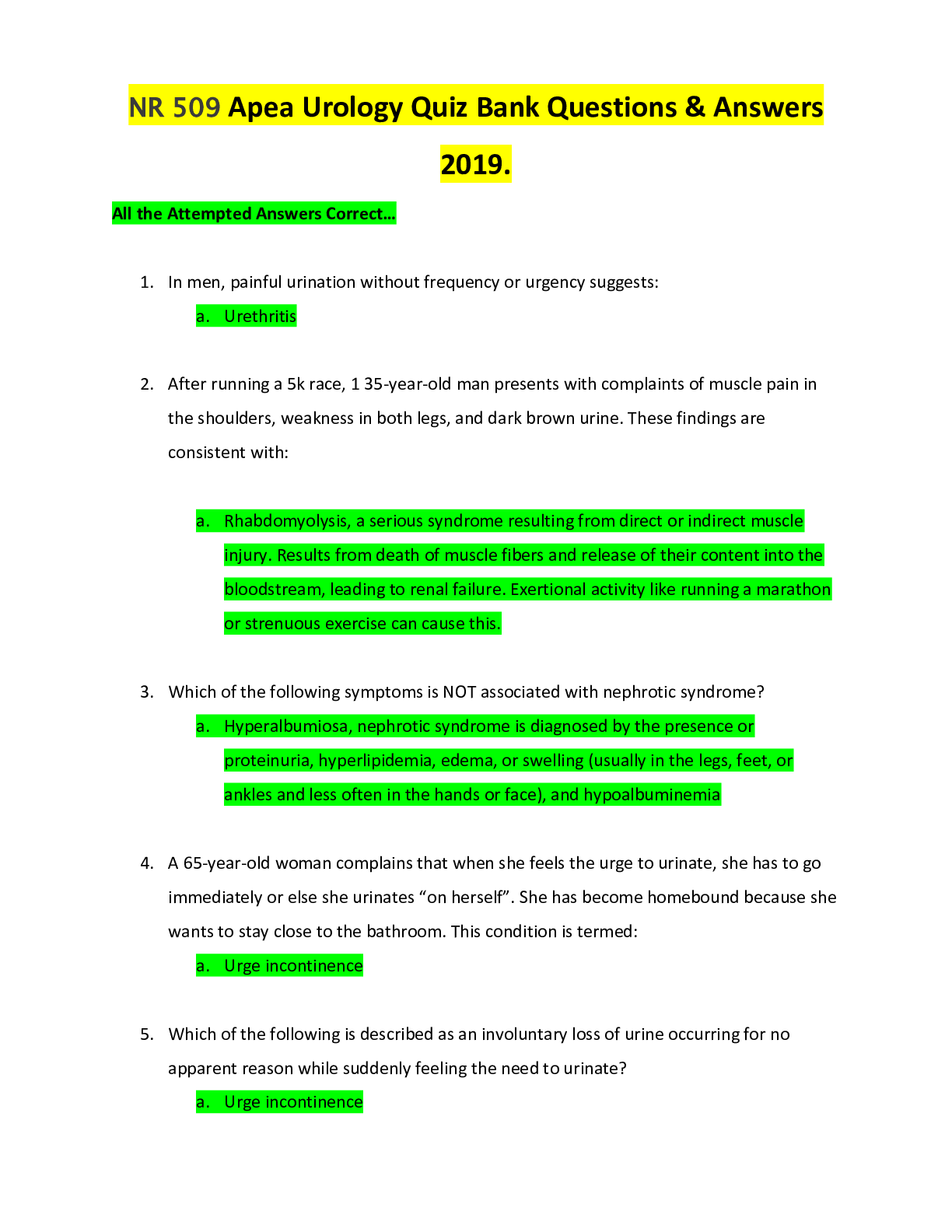*NURSING > EXAM > NR 507 Week 2 Quiz 2020 - Chamberlain College of Nursing |Evolve Chapter 3 Review Questions McCance (All)
NR 507 Week 2 Quiz 2020 - Chamberlain College of Nursing |Evolve Chapter 3 Review Questions McCance Pathophysiology, 7th edition
Document Content and Description Below
NR 507 Week 2 Quiz 2020 (Evolve Chapter 3 Review Questions McCance Pathophysiology, 7th edition) 1. Question 1. When considering water balance, which statement is the correct balance? A. Isot... onic fluids cause increased cellular swelling. B. Hypertonic fluid causes increased cellular swelling. C. Hypotonic fluid causes cellular swelling. D. Hypernatremia causes cellular swelling. 2. Question 2. It is true that hyperchloremia: A. Occurs with a deficit of sodium. B. Occurs with an excess of bicarbonate. C. Has specific symptoms such as thirst. D. Requires treatment of the underlying disorder. 3. Question 3. It is true that hyponatremia: A. Is commonly caused by inadequate sodium intake. B. Can occur with a decrease in total body water (TBW). C. Never occurs with burns, vomiting, or diarrhea. D. Occurs when sodium drops below 135 mEq/L. 4. Question 4. Which statement is true regarding potassium balance? A. Potassium is the major extracellular electrolyte. B. During acidosis, potassium shifts into the cell. C. Aldosterone is secreted when potassium is decreased. D. Insulin causes the movement of potassium into the cell. 5. Question 5. Which statement is true regarding hypokalemia? A. Hypokalemia occurs when the serum level is below 135 mEq/L. B. One cause of hypokalemia is diabetic ketoacidosis. C. Dietary causes of hypokalemia are common. D. Diuretics do not cause hypokalemia. 6. Question 6. Hypernatremia is defined as levels above: A. 147 mEq/L B. 5.5 mEq/L C. 105 mEq/L D. 8.5 mg/dl 7. Question 7. Which statement is true regarding magnesium? A. Hypomagnesemia occurs with a concentration less than 2.5 mEq/L. B. Magnesium is a major extracellular cation. C. Thirty percent is stored in the muscle & bone. D. Symptoms of hypomagnesemia include weakness & depression. 8. Question 8. Which statement describes acidemia? A. State in which the pH of arterial blood is greater than 7.45 B. State in which the pH of arterial blood is less than 7.35 C. Systemic decrease in hydrogen ion concentration D. Systemic excess of base 9. Question 9. Common causes of edema formation (increased filtration of fluid from capillaries & lymph into surrounding tissues) include which of the following? (Select all that apply.) A. Decreased hydrostatic pressure B. Decreased plasma oncotic pressure C. Increased capillary membrane permeability D. Lymphatic obstruction E. Sodium retention 10. Question 10. Which of the following are clinical manifestations of hypokalemia? (Select all that apply.) A. Carbohydrate metabolism is affected as a result of decreased insulin secretion. B. Renal function is impaired. C. Neuromuscular excitability is decreased. D. Skeletal muscle is affected with increased contractility. 11. Question 11. Which treatments are appropriate for hyperkalemia? (Select all that apply.) A. Calcium gluconate B. Treating the contributing cause C. Administering glucagon D. Sodium bicarbonate 12. Question 12. One third of the body’'s fluid is ___ Extracellular ___________. Chapter 34 Questions 1. 1. Which statement is true regarding the pulmonary system? A. The left lobe is divided into three lobes. B. Each lobe is divided into bronchi. C. The mediastinum contains the lungs & heart. D. The larynx connects the upper & lower airways. 2. 2. Which statement is true regarding the lower airways? A. The trachea bifurcates at the larynx. B. The trachea has no supportive structure. C. The right & left main bronchi enter the lungs at the hila. D. The goblet cells are air-filled cells. 3. 3. What process describes the exchange of carbon dioxide (CO2) for oxygen? A. Ventilation B. Respiration C. Circulation D. Alveolar ventilation 4. 4. Which receptor monitors the pH, partial pressure of CO2 (PaCO2) in arterial blood, & partial pressure of oxygen (PaO2) in arterial blood ? A. Stretch receptors B. Irritant receptors C. J-receptors D. Central chemoreceptors 5. 5. Which characteristic is true regarding an individual with emphysema? A. Increased airway resistance B. Increased compliance C. Decreased surfactant D. Increased elastic recoil 6. 6. Which steps are involved in the process of gas exchange? (Select all that apply.) A. Ventilation B. Pressurization C. Diffusion D. Perfusion 7. 7. Which structures are considered part of the upper airway? (Select all that apply.) A. Nasopharynx B. Larynx C. Oropharynx D. Trachea E. Bronchi 8. 8. Which structures are considered part of the acinus? (Select all that apply.) A. Trachea B. Respiratory bronchioles C. Alveolar ducts D. Alveoli E. Larynx 9. 9. Which structures are major accessory muscles of respiration? (Select all that apply.) A. Sternocleidomastoid B. Scalene C. Diaphragm D. External intercostals E. Trapezius 10. 10. Which alterations involved with aging are considered normal? (Select all that apply.) A. Relaxation of chest wall muscles B. Increased flow resistance C. Alterations in gas exchange D. Loss of recoil Chapter 35 1. 1. What is the appropriate term for inadequate alveolar ventilation in relation to metabolic dem&s? A. Hyperpnea B. Hypoventilation C. Orthopnea D. Dyspnea 2. 2. A person has respirations that are characterized by alternating periods of deep & shallow breathing & apnea. What is the appropriate term for this breathing? A. Cheyne-Stokes B. Hypoventilation C. Kussmaul D. Hyperpnea 3. 3. Which disease is associated with bulbous enlargement of the distal segments of the fingers? A. Acute pneumonia B. Acute myocardial infarction C. Sickle cell disease D. Cystic fibrosis 4. 4. Which is the most common cause of pulmonary edema? A. Inhalation of toxic gases B. Heart disease C. Pulmonary hypertension D. Acute respiratory distress syndrome (ARDS) 5. 5. Which statement is true regarding bronchiolitis? A. In adults, a virus usually causes bronchiolitis. B. Bronchiolitis is most common in adults. C. Bronchiolitis is an inflammatory obstruction of the small airways. D. Bronchiolitis is associated with a bacterial infection. 6. 6. What is the term used to describe a respiratory infection that results in pus in the pleural space? A. Abscess B. Consolidation C. Empyema D. Transudate 7. 7. Which statement is true regarding acute respiratory distress syndrome (ARDS)? A. Infection rarely causes ARDS. B. Esophageal injury can cause ARDS . C. ARDS can trigger severe pulmonary edema. D. Macrophages are not involved in the response. 8. 8. Which statement is true regarding the pathophysiologic process of asthma? A. Inflammation results in airway hyperresponsiveness. B. Immunoglobulin A (IgA) is the major factor. C. The inflammatory process is due to the loss of bronchial smooth muscle spasm. D. Vascular permeability increases. 9. 9. Which term describes a hypersecretion of mucus & chronic productive cough that continues for at least 3 months of the year for a minimum of 2 consecutive years? A. Asthma B. Chronic bronchitis C. Emphysema D. Acute respiratory distress syndrome 10. 10. Which pathogen is commonly associated with a pneumonia that is acquired while in the hospital? A. Streptococcus pneumoniae B. Mycoplasma pneumoniae C. Haemophilus influenzae D. Pseudomonas aeruginosa 11. 11. How is tuberculosis spread from person to person? A. Semen to blood contact B. Air droplet C. Direct contact D. Fecal-oral contact 12. 12. Which statements are true regarding viral pneumonia? (Select all that apply.) A. Viral pneumonia requires treatment with antibiotics. B. Viral pneumonia is usually mild & self-limiting. C. Viral pneumonia can set the stage for a secondary bacterial infection. D. Viral pneumonia is not seasonal. Chapter 36 Questions 1. 1. Which statement is true regarding stridor? A. Inspiratory stridor occurs with obstruction of the intrathoracic airway. B. Expiratory stridor is also called a monophonic wheeze. C. The intrathoracic airway is above the thoracic inlet. D. Biphasic stridor is often produced in the lower trachea. 2. 2. Which illness results in a unilateral swelling of the pharynx, fever, sore throat, dysphasia, trismus, & pooling of saliva? A. Diphtheria B. Peritonsillar abscess C. Croup D. Epiglottitis 3. 3. Which statement is true regarding laryngotracheobronchitis? A. Laryngotracheobronchitis is diagnosed most commonly in children from birth to 6 months of age. B. Haemophilus influenzae causes laryngotracheobronchitis. C. The highest incidence of laryngotracheobronchitis occurs in late fall & winter. D. Laryngotracheobronchitis is more common in girls than it is in boys. 4. 4. Which statement is true regarding angioedema? A. Edema of the superficial tissues occurs. B. Beta-blocker use often causes angioedema. C. An allergic phenomenon generally causes angioedema. D. No facial swelling is involved. 5. 5. Which statements are true regarding children’s airways? (Select all that apply.) A. Airway narrowing significantly affects resistance. B. Airway obstruction occurs earlier in infants than it does in children. C. Children have an increased airway diameter. D. Cough is generally a benign condition. E. Children have more cartilage in their airways than do adults. 6. 6. At birth, the tracheobronchial tree is complete; however, the quantity of __ Alveoli_____ increases until 8 years of age. 7. 7. __ Surfactant____ is a lipid-protein mix produced by type II alveolar cells, which reduces surface tension & prevents alveolar collapse. [Show More]
Last updated: 1 year ago
Preview 1 out of 8 pages

Buy this document to get the full access instantly
Instant Download Access after purchase
Add to cartInstant download
We Accept:

Reviews( 0 )
$12.00
Document information
Connected school, study & course
About the document
Uploaded On
Sep 06, 2020
Number of pages
8
Written in
Additional information
This document has been written for:
Uploaded
Sep 06, 2020
Downloads
0
Views
87






















